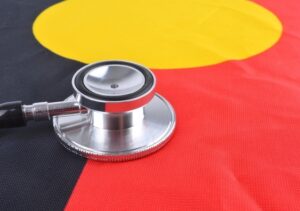It is well known that the health status of Aboriginal and Torres Strait Islander peoples is significantly lower than that of non-Indigenous Australians, and has been since comparisons started being made. This inequity remains despite 33 years since the recommendations of the National Aboriginal Health Strategy, 31 years since the recommendations of the Royal Commission into Aboriginal Deaths in Custody, 19 years of National Reconciliation efforts, and 14 years since the establishment of the Close the Gap framework. As an Aboriginal person who has been involved in advocating for improvement in Aboriginal and Torres Strait Islander health for the last 25 years or more, its difficult to explain the heartbreak and frustration that comes with seeing so little change after so much effort from so many people. Those feelings and experiences are what led me to initiate the Walk the Talk for Aboriginal and Torres Strait Islander Health project.
Yet when I look for news of things happening in Aboriginal and Torres Strait Islander health, and as I progress through my virtual tour of Aboriginal and Torres Strait Islander health services, it becomes apparent that there is a lot of good things happening both at community levels and amongst key stakeholders. On the surface it would seem that Aboriginal and Torres Strait Islander health status is improving; so why is there still such disparity in health status compared to non-Indigenous Australians?
This led me to ask myself: is Aboriginal and Torres Strait Islander health actually improving? Am I just so disillusioned that I’m incorrect in my belief that nothing is changing?
To try and answer this, I decided to do a comparison of reports by one of the leading expert bodies on Aboriginal and Torres Strait Islander health reporting, the Australian Indigenous HealthInfoNet. I decided to look at the latest report, the Overview of Australian Indigenous health status 2021, and compare it to what was reported ten years previous (Overview of Australian Indigenous health status 2011). Making such a comparison wasn’t as straightforward as I imagined it would be – the presentation of reports was similar, but had changed enough that it wasn’t easy to compare like with like. A deep dive into the raw data would make for a more direct analysis, however for my purposes I was able to make the following comparisons.
First Things First – Who Are We Looking At?
In the ten years between reports, the reported combined Aboriginal and Torres Strait Islander population in Australia increased over 53% from 575,552 in 2011 to 881,593 in 2021. While identified births per year – that is, recorded births where at least one of the parents identifies as Aboriginal or Torres Strait Islander – have also increased about 36.5% over the ten years, from 16,129 in 2011 to 22,016 in 2021, even assuming that the latest number of identified births was about the same for all the years in between, birthrate alone would not account for the increase in population. While it’s possible that improvements in data collection may account for the difference, it’s more likely a reflection that there continues to be an increase in the number of people who chose to formally identify as Aboriginal or Torres Strait Islander.
New South Wales continues to have the most Aboriginal and Torres Strait Islander peoples with slight growth (about 4%) over the period, while the Northern Territory continues to have the highest proportion of Aboriginal and Torres Strait Islander peoples compared to the non-Indigenous population, again with slight growth (about 2%).
What Has Improved?
While it was hard to compare everything, it does seem some things, at least on the surface, have improved.
Life expectancy – a key indicator for Close The Gap – has improved for both Aboriginal and Torres Strait Islander women and men. For women life expectancy increased by 3.7% from 72.9 years to 75.6 years, while men’s life expectancy increased by 6.5% from 67.2 years to 71.6 years. Whether this is statistically significant is unknown, however it does seem to be trending in the right direction. What doesn’t seem to be changing much is the gap between Aboriginal and Torres Strait Islander and non-Indigenous life expectancy. Over ten years, the gap only reduced from 10 years in 2011 to 8-9 years in 2021. It would seem then that despite increasing our overall lifespan, we have not improved it to be equitable with the non-Indigenous population.
Other apparent areas of improvement over the ten year period are detailed in the table below:
| Death related injuries | the incidence of deaths related to traumatic (physical) injury decreased by 20% to 12% of all deaths (the rate for the total Australian population is 8.4%) |
| Immunisation | immunisation rates increased by 10.2% to 97% of all Aboriginal and Torres Strait Islander children (the rate for the total Australian population is 94.4%) |
| Breast feeding | the number of children 0-2 years of age who were breast fed increased by 3.6% to 87% of all children (the rate for the total Australian population was 90% in 2010 – more recent data could not be found) |
| Smoking | tobacco use decreased by 2.6% to 37% of all Aboriginal and Torres Strait Islander peoples (the rate for the total Australian population is 11.8%) |
While these improvements are definitely positive, the continued differences when compared with the greater Australian population could explain why, despite an increased overall lifespan, there is still a signficiant gap between Aboriginal and Torres Strait Islander peoples, and non-Indigenous Australians.
What Hasn’t Improved?
Again it was hard to make direct comparisons between the reports, however there were some standout areas where it appears things haven’t significantly improved, stayed about the same, or have in fact gotten worse:
| Birthweight | the average birthweight for newborns increased by 0.5% from 3,196 grams to 3,211 grams (the average for the total Australian population was 3,328 in 2017 – more recent data could not be found) |
| Hospitalisations | the hospitalisation rate increased by 33.3% (accurate comparative data for the total Australian population could not be found) |
| Cardiovascular disease | the proportion of Aboriginal and Torres Strait Islander peoples diagnosed with cardiovascular disease increased by 25% to 15% of the population (the proportion for the total Australian population is 16.6%) |
| Respiratory disease | the proportion of Aboriginal and Torres Strait Islander peoples diagnosed with respiratory disease increased by 7.4% to 29% of the population (the proportion for the total Australian population is 31%) |
| Eye health | the proportion of Aboriginal and Torres Strait Islander peoples diagnosed with diseases of the eye increased by 26.7% to 38% of the population (accurate comparative data for the total Australian population could not be found) |
| Alcohol use | the proportion of Aboriginal and Torres Strait Islander peoples abstaining from alcohol use decreased by 25.7% to 26% of the population (the proportion for the total Australian population is 23%) |
It’s important to recognise that while the prevalence of some disease appears to be lower for Aboriginal and Torres Strait Islander peoples compared to non-Indigenous Australians, the fact that on average Aboriginal and Torres Strait Islander peoples don’t live as long as non-Indigenous Australians likely skews these comparisons if at least some diagnoses are being made later in life. It is also likely that the significantly increased mortality rates amongst Aboriginal and Torres Strait Islander peoples (compared to non-Indigenous Australians) for treatable or preventable diseases influences these comparisons, as some Aboriginal and Torres Strait Islander peoples are simply not living long enough to be diagnosed with these conditions.
So, is Aboriginal and Torres Strait Islander Health Improving?
Although this is a simple comparison, when we look at these results and come back to the question, “Is Aboriginal and Torres Strait Islander health improving?”, I can’t help but think the answer comes from the character of an animated series on television: “short answer, ‘yes’ with an ‘if’, long answer ‘no’ with a ‘but’.”
It’s clear that there have been improvements in specific areas; for me the standout improvement has been in immunisation rates for Aboriginal and Torres Strait Islander children. These need to be recognised and encouraged so they can be maintained and built upon. From the data presented and my experience to date through the Walk the Talk program, I expect that if you looked at individual communities or regions you would find evidence of standout improvements in a variety of measures at the local level.
However, when you look at the bigger picture and the whole health status of Aboriginal and Torres Strait Islander peoples, it becomes harder to say that things are improving. In fact you could be forgiven for believing that things are in fact getting worse, and there’s certainly evidence this is what’s happening in certain areas. To be fair, this comparison is only superficial at best, and a more accurate conclusion may be able to drawn using statistical analysis of the raw data. In addition, it’s difficult to gauge the impact extrinsic factors have on the data we’re presented with. For example, what influence has two years of COVID-19 and all the issues that go with it had on the data? Does population variance by cultural identification versus live births skew the data, and if so, how? Are reporting procedures robust enough to even be able to make accurate comparisons across timeframes?
For that matter, how do we define what ‘improvement’ looks like? Is it merely a positive shift in the prevalence of certain diseases, or risk factors associated with diseases? Is it coming closer to an equitable comparison with the non-Indigenous Australian population? What about when we take into account the Aboriginal and Torres Strait Islander definition of health, which encompasses so much more than physical and mental health?
For myself, as an Aboriginal man, an advocate for Aboriginal and Torres Strait Islander health and Indigenous health worldwide, and a health professional who has spent over half my life involved in these issues, I will recognise that Aboriginal and Torres Strait Islander health is improving when:
- a) we demonstrate positive, statistically significant changes in the majority of measures used in determining our overall health status; and
- b) we demonstrate there is no statistically significant difference between the majority of measures of health status for Aboriginal and Torres Strait Islander peoples and non-Indigenous peoples.
Until that day, we’ve still got a lot of work to do.
What do you think? Please feel free to share your thoughts in the comments below.


